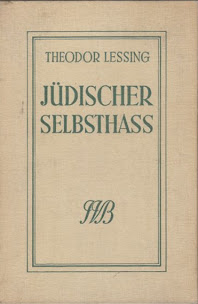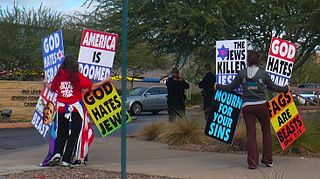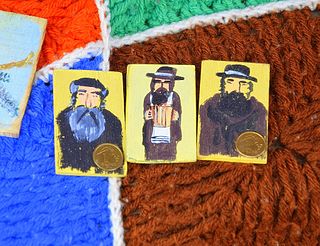Related Research Articles
Antisemitism is hostility to, prejudice towards, or discrimination against Jews. This sentiment is a form of racism, and a person who harbours it is called an antisemite. Though antisemitism is overwhelmingly perpetrated by non-Jews, it may occasionally be perpetrated by Jews in a phenomenon known as auto-antisemitism. Primarily, antisemitic tendencies may be motivated by negative sentiment towards Jews as a people or by negative sentiment towards Jews with regard to Judaism. In the former case, usually presented as racial antisemitism, a person's hostility is driven by the belief that Jews constitute a distinct race with inherent traits or characteristics that are repulsive or inferior to the preferred traits or characteristics within that person's society. In the latter case, known as religious antisemitism, a person's hostility is driven by their religion's perception of Jews and Judaism, typically encompassing doctrines of supersession that expect or demand Jews to turn away from Judaism and submit to the religion presenting itself as Judaism's successor faith—this is a common theme within the other Abrahamic religions. The development of racial and religious antisemitism has historically been encouraged by anti-Judaism, though the concept itself is distinct from antisemitism.
Antisemitism and the New Testament is the discussion of how Christian views of Judaism in the New Testament have contributed to discrimination against Jewish people throughout history and in the present day.

Semitic people or Semites is an obsolete term for an ethnic, cultural or racial group associated with people of the Middle East, including Arabs, Jews, Akkadians, and Phoenicians. The terminology is now largely unused outside the grouping "Semitic languages" in linguistics. First used in the 1770s by members of the Göttingen School of History, this biblical terminology for race was derived from Shem, one of the three sons of Noah in the Book of Genesis, together with the parallel terms Hamites and Japhetites.

Philosemitism, also called Judeophilia, is the feeling or expression of interest in, respect for, and appreciation of Jews on the part of a non-Jew. It is signified by a non-Jewish individual's fondness for Jewish history, Jewish culture, and Judaism. Although pro-Jewish sentiment has been attested in a number of societies since antiquity, the concept of philosemitism in a modern context has largely been defined by the aftermath of World War II and particularly by the memory of the Holocaust, which was the most violent culmination of antisemitism in recent history. Despite the fact that it is effectively the opposite of antisemitism, American-Jewish historian Daniel Cohen of the Vienna Wiesenthal Institute for Holocaust Studies has asserted that philosemitism "can indeed easily recycle antisemitic themes, recreate Jewish otherness, or strategically compensate for Holocaust guilt."
The history of antisemitism, defined as hostile actions or discrimination against Jews as a religious or ethnic group, goes back many centuries, with antisemitism being called "the longest hatred". Jerome Chanes identifies six stages in the historical development of antisemitism:
- Pre-Christian anti-Judaism in Ancient Greece and Rome which was primarily ethnic in nature
- Christian antisemitism in antiquity and the Middle Ages which was religious in nature and has extended into modern times
- Muslim antisemitism which was—at least in its classical form—nuanced, in that Jews were a protected class
- Political, social and economic antisemitism during the Enlightenment and post-Enlightenment Europe which laid the groundwork for racial antisemitism
- Racial antisemitism that arose in the 19th century and culminated in Nazism
- Contemporary antisemitism which has been labeled by some as the new antisemitism
Rootless cosmopolitan was a pejorative Soviet epithet which referred mostly to Jewish intellectuals as an accusation of their lack of allegiance to the Soviet Union, especially during the antisemitic campaign of 1948–1953. This campaign had its roots in Joseph Stalin's 1946 attack on writers who were connected with "bourgeois Western influences", culminating in the "exposure" of the non-existent Doctors' Plot in 1953.

Zygmunt Bauman was a Polish-born sociologist and philosopher. He was driven out of the Polish People's Republic during the 1968 Polish political crisis and forced to give up his Polish citizenship. He emigrated to Israel; three years later he moved to the United Kingdom. He resided in England from 1971, where he studied at the London School of Economics and became Professor of Sociology at the University of Leeds, later emeritus. Bauman was a social theorist, writing on issues as diverse as modernity and the Holocaust, postmodern consumerism and liquid modernity.

The terms "self-hating Jew", "self-loathing Jew" and auto-antisemite are pejorative terms used to describe a Jew whose viewpoints on any specific matter are perceived as antisemitic.
Bogdan Musiał is a Polish-German historian. In 1985 he left Poland and became a political refugee in Germany, where he obtained German citizenship. In 2010 he returned to Poland and became a professor at the Cardinal Stefan Wyszyński University in Warsaw.
Antisemitism —prejudice, hatred of, or discrimination against Jews— has experienced a long history of expression since the days of ancient civilizations, with most of it having originated in the Christian and pre-Christian civilizations of Europe.

Antisemitism has long existed in the United States. Most Jewish community relations agencies in the United States draw distinctions between antisemitism, which is measured in terms of attitudes and behaviors, and the security and status of American Jews, which are both measured by the occurrence of specific incidents.
Antony Lerman is a British writer who specialises in the study of antisemitism, the Israeli–Palestinian conflict, multiculturalism, and the place of religion in society. From 2006 to early 2009, he was Director of the Institute for Jewish Policy Research, a think tank on issues affecting Jewish communities in Europe. From December 1999 to 2006, he was Chief Executive of the Hanadiv Charitable Foundation, renamed the Rothschild Foundation Europe in 2007. He is a founding member of the Jewish Forum for Justice and Human Rights, and a former editor of Patterns of Prejudice, a quarterly academic journal focusing on the sociology of race and ethnicity.
The Institute for Jewish Policy Research (JPR), founded as the Institute of Jewish Affairs, is a London-based research institute and think tank. It specialises in contemporary Jewish affairs. JPR also runs a public education programme, and has hosted lectures from Chief Rabbi Lord Sacks, James Wolfensohn, Professor Jonathan Sarna and Professor Zygmunt Bauman.
Głos was a Polish language social, literary and political weekly review published in Warsaw between 1886 and 1905. It was one of the leading journals of the Polish positivist movement. Many of the most renowned Polish writers published their novels in Głos, which also became a tribune of the naturalist literary movement of the late 19th century. During the Revolution of 1905 it was closed down by tsarist authorities.
Jewish Koine Greek, or Jewish Hellenistic Greek, is the variety of Koine Greek or "common Attic" found in a number of Alexandrian dialect texts of Hellenistic Judaism, most notably in the Septuagint translation of the Hebrew Bible and associated literature, as well as in Greek Jewish texts from Palestine. The term is largely equivalent with Greek of the Septuagint as a cultural and literary rather than a linguistic category. The minor syntax and vocabulary variations in the Koine Greek of Jewish authors are not as linguistically distinctive as the later language Yevanic, or Judeo-Greek, spoken by the Romaniote Jews in Greece.
Evidence for the presence of Jewish communities in the geographical area today covered by Austria can be traced back to the 12th century. In 1848 Jews were granted civil rights and the right to establish an autonomous religious community, but full citizenship rights were given only in 1867. In an atmosphere of economic, religious and social freedom, the Jewish population grew from 6,000 in 1860 to almost 185,000 in 1938. In March 1938, Austria was annexed by Nazi Germany and thousands of Austrians and Austrian Jews who opposed Nazi rule were sent to concentration camps. Of the 65,000 Viennese Jews deported to concentration camps, only about 2,000 survived, while around 800 survived World War II in hiding.

The Jew with a coin is a good-luck charm in Poland, where images or figurines of the character, usually accompanied by a proverb, are said to bring good fortune, particularly financially. The motif was first described in articles from 2000, and probably dates back to the early 1990s. While widely recognized, the figurines are not the most popular good-luck charm in Poland.

Artur Sandauer was a Polish and Jewish literary critic, essayist, and professor at the University of Warsaw.
Anti-antisemitism is opposition to antisemitism or prejudice against Jews, and just like the history of antisemitism, the history of anti-antisemitism is long and multifaceted. According to historian Omer Bartov, political controversies around antisemitism involve "those who see the world through an antisemitic prism, for whom everything that has gone wrong with the world, or with their personal lives, is the fault of the Jews; and those who see the world through an anti-antisemitic prism, for whom every critical observation of Jews as individuals or as a community, or, most crucially, of the state of Israel, is inherently antisemitic". It is disputed whether or not anti-antisemitism is synonymous with philosemitism, but anti-antisemitism often includes the "imaginary and symbolic idealization of ‘the Jew’" which is similar to philosemitism.
Zionist antisemitism is the phenomenon in which individuals, groups, or governments support the Zionist movement and the State of Israel while simultaneously holding antisemitic views about Jews. In some cases, Zionism may be promoted for explicitly antisemitic reasons. The prevalence of antisemitism has been widely noted within the Christian Zionist movement, whose adherents may hold antisemitic beliefs about Jews while also supporting Zionism for eschatological reasons. Antisemitic right-wing nationalists, particularly in Europe and the United States, sometimes support the Zionist movement because they wish for Jews to be expelled, or for Jews to emigrate to Israel, or because they view Israel as a supremacist ethno-state to be admired and held up as a model for their own countries.
References
- ↑ Artur Sandauer, O sytuacji pisarza polskiego pochodzenia żydowskiego w XX wieku (Rzecz, którą nie ja powinienem był napisać...) (Warszawa: Czytelnik, 1982, p. 9.
- ↑ Published in English as: Artur Sandauer, On the Situation of the Polish Writer of Jewish Descent in the Twentieth Century : It Is Not I Who Should Have Written This Study...Trans. Abe Shenitzer, Ed. Scott Ury (Jerusalem: Hebrew University Magnes Press, 2005).
- ↑ Zygmunt Bauman, “Allosemitism: Premodern, Modern, Postmodern,” in Modernity, Culture, and “the Jew,” ed. Bryan Cheyette and Laura Marcus (Cambridge: Polity Press, 1998)
- ↑ Weinstein, Valerie. "Dissolving Boundaries: Assimilation and Allosemitism in E. A. Dupont's "Das Alte Gesetz" (1923) and Veit Harlan's "Jud Süss" (1940)." The German Quarterly 78.4 (2005): 496-516.
- ↑ Eva Frojmovic. Review of Kessler, Herbert L.; Nirenberg, David, eds., Judaism and Christian Art: Aesthetic Anxieties from the Catacombs to Colonialism, H-Judaic, H-Net Reviews. March, 2013.
- 1 2 Gruber, Ruth (7 August 2008). "Allosemitism (noun)—Jews as the perpetual 'other'". Jewish Journal. Retrieved 10 August 2016.
- 1 2 Briefel, Aviva. "Allosemitic Modernism." Novel: A Forum on Fiction 43, no. 2 (2010): 361-63. https://www.jstor.org/stable/40959717.